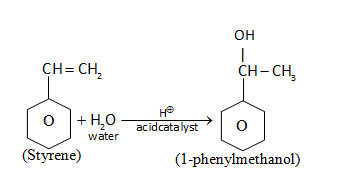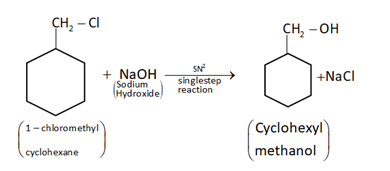
Show how you will synthesise:
(i) 1-Phenylethanol from a suitable alkene.
(ii) Cyclohexylmethanol using an alkyl halide by a \[S{N^2}\]reaction.
(iii) Pentan-1-ol using a suitable alkyl halide.
Answer
142.8k+ views
Hint: These reactions are either electrophilic addition or nucleophilic substitution reaction. In an electrophilic addition reaction, a $\pi $ bond is broken and two new $\sigma $ bonds are formed. In nucleophilic substitution reaction, a leaving group is replaced by an electron rich compound.
Complete step by step solution:
Synthesis of the following reaction:
(i) 1-phenylethanol from suitable alkene.
Alkene is treated with \[{H_2}O\]in the presence of acid (acid catalyzed hydrolysis) to give 1-phenylmethanol

(ii) Cyclohexylmethanol using an alkyl halide by a \[S{N^2}\] reaction.
When chloromethylcyclohexane is treated with sodium hydroxide, then it will give cyclohexylmethanol by \[S{N^2}\]mechanism.

(iii) Pentan-1-ol using a suitable alkyl halide.
When chloropentane is treated with aq.$NaOH$, then it will give pentan-1-ol.
\[\mathop {C{H_3}C{H_2}C{H_2}C{H_2}C{H_2}}\limits_{\left( {1 - Chloropen\tan e} \right)} - Cl + \mathop {aq.NaOH}\limits_{\left( \begin{subarray}{l}
Sodium \\
Hydroxide
\end{subarray} \right)} \xrightarrow{{}}\mathop {C{H_3}C{H_2}C{H_2}C{H_2}C{H_2} - OH + NaCl}\limits_{\left( {Pen\tan - 1 - ol} \right)} \]
Note: Alpha methylbenzyl alcohol appears as a colourless liquid which is insoluble in water and less dense than water. Cyclohexylmethanol is an organic compound and these reactions are bimolecular nucleophilic substitution reactions. 1 - Pentanol is a colourless liquid with a distinctive aroma. It is the straight- chain form of amyl alcohol and the hydroxyl group is the active site of many reactions. Electrophilic addition reactions are an important class of reaction that allow the inter conversion of $C = C$and $C \equiv C$ into a range of important functional groups including alkyl halides and alcohols. Addition reaction is the reverse of elimination reactions and in nucleophilic substitution reactions, the stronger nucleophile replaces a weaker nucleophile.
Complete step by step solution:
Synthesis of the following reaction:
(i) 1-phenylethanol from suitable alkene.
Alkene is treated with \[{H_2}O\]in the presence of acid (acid catalyzed hydrolysis) to give 1-phenylmethanol

(ii) Cyclohexylmethanol using an alkyl halide by a \[S{N^2}\] reaction.
When chloromethylcyclohexane is treated with sodium hydroxide, then it will give cyclohexylmethanol by \[S{N^2}\]mechanism.

(iii) Pentan-1-ol using a suitable alkyl halide.
When chloropentane is treated with aq.$NaOH$, then it will give pentan-1-ol.
\[\mathop {C{H_3}C{H_2}C{H_2}C{H_2}C{H_2}}\limits_{\left( {1 - Chloropen\tan e} \right)} - Cl + \mathop {aq.NaOH}\limits_{\left( \begin{subarray}{l}
Sodium \\
Hydroxide
\end{subarray} \right)} \xrightarrow{{}}\mathop {C{H_3}C{H_2}C{H_2}C{H_2}C{H_2} - OH + NaCl}\limits_{\left( {Pen\tan - 1 - ol} \right)} \]
Note: Alpha methylbenzyl alcohol appears as a colourless liquid which is insoluble in water and less dense than water. Cyclohexylmethanol is an organic compound and these reactions are bimolecular nucleophilic substitution reactions. 1 - Pentanol is a colourless liquid with a distinctive aroma. It is the straight- chain form of amyl alcohol and the hydroxyl group is the active site of many reactions. Electrophilic addition reactions are an important class of reaction that allow the inter conversion of $C = C$and $C \equiv C$ into a range of important functional groups including alkyl halides and alcohols. Addition reaction is the reverse of elimination reactions and in nucleophilic substitution reactions, the stronger nucleophile replaces a weaker nucleophile.
Recently Updated Pages
How to find Oxidation Number - Important Concepts for JEE

How Electromagnetic Waves are Formed - Important Concepts for JEE

Electrical Resistance - Important Concepts and Tips for JEE

Average Atomic Mass - Important Concepts and Tips for JEE

Chemical Equation - Important Concepts and Tips for JEE

Concept of CP and CV of Gas - Important Concepts and Tips for JEE

Trending doubts
JEE Main 2025 Session 2: Application Form (Out), Exam Dates (Released), Eligibility, & More

JEE Main Exam Marking Scheme: Detailed Breakdown of Marks and Negative Marking

JEE Main 2025: Derivation of Equation of Trajectory in Physics

Electric Field Due to Uniformly Charged Ring for JEE Main 2025 - Formula and Derivation

Types of Solutions

Degree of Dissociation and Its Formula With Solved Example for JEE

Other Pages
JEE Advanced Marks vs Ranks 2025: Understanding Category-wise Qualifying Marks and Previous Year Cut-offs

JEE Advanced 2025: Dates, Registration, Syllabus, Eligibility Criteria and More

NCERT Solutions for Class 11 Chemistry Chapter 5 Thermodynamics

JEE Advanced Weightage 2025 Chapter-Wise for Physics, Maths and Chemistry

Hydrocarbons Class 11 Notes: CBSE Chemistry Chapter 9

NCERT Solutions for Class 11 Chemistry In Hindi Chapter 1 Some Basic Concepts of Chemistry




